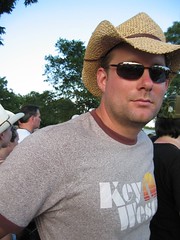Wednesday, October 26, 2005
Special Guest Post: Grandpa Fred
I’ve been waiting a month for divine revelation to tell me how to add on to the end of Alan’s blog about our China trip, but alas, it has not come. The words have been buzzing around in my head all this time, so it is time to get them out.
The road (paved road) ends about 5km out of Kunming. From there it is only rough stones about the size of two bricks. These stones are uneven, so it’s very rough. Our van rattles and vibrations to the extent that we must shout to carry on a conversation. We are on way to Lake Nuguru which is about 200km from Kunming and will take us about six hours to get there.
Our driver doesn’t speak English but it is evident that he has driven this road many times. It is breakneck speed all the way and this is on mountain roads that ascend to ridges and then descend into valleys. Out driver explains with his hands that there are six more ridges to cross. Anything that moves up ahead must be passed, so we bear down on them and shoot past no matter what lies ahead. In addition there are numerous rock slides that have fallen on the road and in some places the road is washed away with only one lane remaining. You might say that the road itself is “a trip.” Our driver is in love with his horn, blowing it at everything that moves or might move along the way. He blows it on curves , also, which is a good thing.
Alan left us in Shanghai where Brad very graciously supplied transport to the airport for him. Later, after a five hour delay, we flew south on China Eastern, one of China’s excellent domestic airlines. We were met at the Kunming airport and taken to a prominent hotel which had an impressive lobby but nonfunctioning plumbing (we had to change rooms).
The next day it was a two hour flight to Lijang, an ancient city that is the home of the Naxi minority group. We had planned to make this part of the trip on our own, but thankfully, Dr. Peter Tang and Brad realized that would need help so they made arrangements for us. ijang reminded me of Waikiki. The Naxi culture was there somewhere but it was hard to find with all the souvenir shops, restaurants and bars catering to tourists from all over the world, but mainly from China itself. We found a place called Sakoura that served everything from congee to crepes for breakfast.
Out accommodations were in a guest house (“300 years old”) perched on the side of a hill with tiny passageways and doorways. The beds were the hardest yet but that was the least of our problems. There might have been a shower somewhere but it wasn’t in our room. Toilets were down the hall.
One evening we attended a concert of traditional Naxi music, a must in Lijang. This same music with ancient instruments was performed for the last emperor of China hundreds of years ago. Lots of clangs and bells played by wonderful old men who were very serious about there performance. Every afternoon the Naxi ladies in there traditional dress performed their dances in an open plaza……just like the Kodak hula show in Honolulu.
This morning it was into the van and off to Lake Nuguru. We finally go over the last ridge and drop down toward the extensive lake dotted with several islands. Instead of going to our “hotel” the driver took us down to the lake shore. We were ushered out and into a rough hewn canoe with about eight others and paddled off toward one of the islands that had a pagoda. Numerous other boats were going and coming and being paddled by minority ladies in their colorful dress as well as some men.
We climbed to the pagoda and found that it was a Tibetan Buddhist with prayer wheels around the outside. Prayer flags fluttered from lines strung among the trees and wild dahlias marked the landscape. Judy spoke to the monk on duty inside.
Then it was back into the boats and back to where we started.
Tuesday, October 25, 2005
275 MPH And No Seat Belts
"Hmm, no seat belts."
Not like seat belts would do a whole lot in a crash anyway.
The Maglev Bullet train was an exciting but wholly unnatural experience. I think it may be the fastest commercial train in the world right now. A top speed of 275 mph thanks to a precisely tuned magnetic cushion and some brilliant German engineering.
The train follows a single route; a short 10 minute ride from the Shanghai business center to the international airport... and then back again. Not exactly a scenic tour, but then again, you can't see a whole lot when you're clipping along at 1/3 the speed of sound...on the ground.
It's a suprisingly smooth ride, except when you pass the oncoming train on the adjacent track...also speeding at 275mph. That's when you hear/feel the loud THUMP of the two air streams smashing into each other at combined speed faster than a Commercial jet at crusing speed.
New pictures of Maglev Train and Video Of Train Ride
Shanghai: World’s Largest Rolex and Louis Vuitton Outlet Store
2 authentic* Louis Vuitton bags for $35 bucks!
2 genuine** Rolex watches for 15 bucks!
I must have good karma or something (thank you feudal serf me from 800 years ago!)
When we arrived at shanghai, the last city stop on our grand tour, we had no idea that we were entering the world’s greatest city-sized Outlet Mall.
No, at the time, we were more concerned about the Typhoon that was predicted to hit us the next day.
Silly me to think that I was escaping the natural disasters currently plaguing the US! It seems God dislikes communists just about as much as he detests red-staters and neo-cons…
The Typhoon, thankfully, was not the second coming of Katrina. It churned out just enough rain and wind to clear out the smog for one good day of site seeing and picture taking.
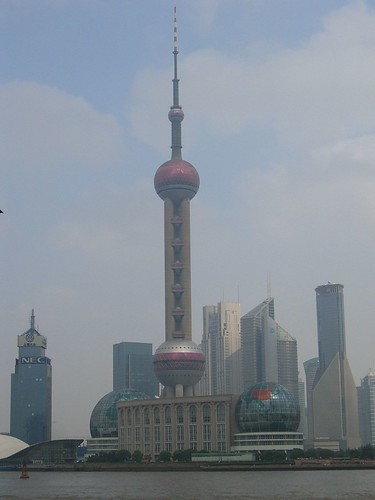
Shanghai, unlike the other cities visited, is a city mostly devoid of the historic tourist sites we were used to visiting. Instead, the real draw of Shanghai seemed to be the cosmopolitan identity it has acquired throughout its interesting history. While the traffic and overpopulation was similar to the other large cities we visited, the overall feel of the city was much more Western in nature (almost space-age in some respects!) with towering skyscrapers (one of which is the fifth tallest in the world) and older, classical western European influenced structures – a stark departure from the sterile utilitarian designs in Beijing and Xian.
After a day of driving to the tourist spots, which aren’t interesting enough to write about here, we felt like we were more than ready for the power shopping that would dominate the remainder of our stay.
Before I go any further, I think a little clarification is in order. When I speak of shopping, I’m not referring to the khaki-pants-buying-at-the-mega-mall variety that (strangely) seemed to attract most of the others in the group (don’t they have malls back at home?).
Nah, I’ve had enough of South Coast Plaza to last me for awhile.
What I’m referring to is “guy shopping.” Y'know.... the shady kind that involves, back-room negotiations for pirate dvd’s, fake swiss watches, grey market electronics and maybe a designer handbag or two for my wife thrown in for good measure.
Throughout the city, strategically placed near the established markets and malls, are groups of shopping “assistants” whose sole purpose is to bring interested buyers to the secretive shops that cater to the fake brand-name product bargain hunter. Usually these shops are accessible only through secret trap doors located behind display cases at legitimate “front” stores but sometimes they can be setup at an apartment or at the end of a series of stairways and inconspicuous doors that seem to lead to the other side of nowhere.
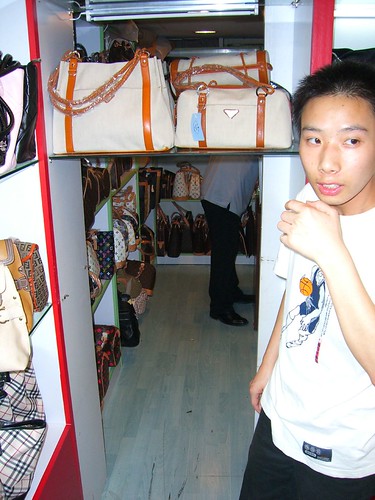
One can really only tolerate this process for a couple of days. The constant squawks of “sir, you want rolex…your want louis vuitton…you want versace… and the occasional arm grab by the super-pushy shop owners gets old real fast. Once I acquired my booty, and the suitcase to transport it back to the states, I made like a stray dog walking by a Chinese dumpling factory and disappeared.
* Authenticity confirmed by enthusiastic declaration and many promises made by handbag sales associate
** Rolexes were deemed genuine due to the genuine-looking rolex symbol on watch face
New Pictures: The Bund and Jade Buddha and Lu Gardens and Shopping/Misc.
Monday, October 03, 2005
Budweiser Tastes Better In Southern China
The Chinese know how to party. Faggedabout any myth you’ve heard about Chinese gene incompatibility with alcohol.
They’ve also figured out the whole nightlife scene as well. Each city we visited had a hot, happening and crowded bar and club district with high-end clubs comparable to the elite night spots in LA, New York and Vegas.
We happened upon one of these joints quite by accident after a kick-ass post dinner hour long reflexology foot massage (costing a whopping 12 bucks!).
We skipped out on the tour bus back to the hotel, bidding farewell to our happy footed friends and ventured out to see what Saturday night Guilin had to offer.
Although the hotel concierge suggested there might be a few bar areas downtown, we didn’t have any expectations, especially considering this was supposedly such a tiny little podunk Chinese town of only 600,000. But as we rounded the corner onto the major city blvd…
HOLY KUNG PAO EATING INSOMNIAC BATMAN! LOOK AT ALL THE PEOPLE!
We made our way to the bar district, walking past thousands of late nighting Guilinites who were checking out the 50 or so street fair booths hocking all varieties of handicrafts, food and the latest greatest cure-all Chinese potions.
The bar district was real cool with at least 10-15 night clubs and bars, each with Neon-lit signs and booming dance music pouring out from open doors and windows. For a moment, I thought I was back home on Sixth Street during a particularly raucous weekend party night.
We walked into one of the noisier clubs; a place that came recommended by our Guilin tour guide and took a seat at one of the tables. The place was packed and had all the familiar night club elements from home including a DJ, ear to his headphone, intently mixing the next track on dual turntables; light and laser displays including a huge LED light installation behind the DJ booth with an eye-popping, choreagraphed light display; wide screen, flat panel TVs with the latest European music videos playing and…. THE BUD GIRLS???
What the…?
"How strange is THIS??" I thought to myself.
I’m in a little city in Central China at a nightclub that could easily be the hottest spot on South Beach listening to really good house music and drinking a bottle of Budweiser I just purchased from the Chinese Bud Girls.
This was so surreal.
And then as fate would have it… it got even better. A girl from the audience stood up on a raised platform directly in front of the DJ booth, the DJ slapped a new disc on the turntable…a faintly familiar melody remixed to include a deep bass line… And she starts singing: HIT ME BABY ONE MORE TIME BY BRITTANY SPEARS!...IN ENGLISH NO LESS!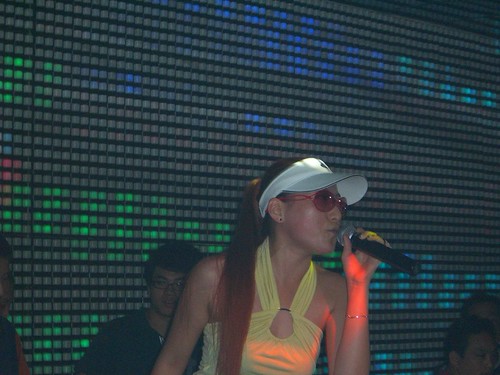
This was too good to be true. And oh did she work that song. This girl belted out the Brittany like she was on the finale of Chinese-American Idol…
And then a hidden rumbling from deep within…. I was overcome by an urgent need to dance. It must have been the Brittany….or the 3 Smooth, Crisp, Beachwood Aged Budweisers I just downed. Either way, I couldn’t deny the slow rhythmic lurchings of my waist.
Crap. Not now! Must…. Stop…..Hips….And….White….Man’s….Overbite…
Damn You Snake Wine!
Then I remembered …we were the only white people at the club. Well, actually, I was the only white person as my cohorts were Canadians of Asian descent. And boy did my blonde buzz-cut head glow. I looked like Super Honky covered with extra mayo and finished with two fresh slices of Wonder Bread.
If I started dancing, I would surely become the newest comedy sensation in all of Asia.
Thankfully, the angel on my shoulder prevailed and I planted my ass squarely on the chair… but not without a slight head bob from time to time.
After a few more Budweisers, I decided to let my photography subjects party in peace, so I left the club and looked for a ride back to the hotel.
Against the strong recommendations by our tour guide NOT to use the very dangerous local motorcycle taxi cab transportation system (remember… the Chinese drive like shite!), I strapped on a plastic contruction worker “helmet” with no padding and held on for dear life for a 10 minute ride back to the hotel.
New Pictures: GUILIN NIGHT CLUB and GUILIN MISCELLANOUS
Snake Wine Shooters On The Li River
The next stop on our grand tour was Guilin. Described by our city guide Carol as a “small town” of 600,000, it was the most beautiful of the 4 cities we visited. While still very Chinese in its character, the majority of the city was restored about 8 years ago so all the city squares, streets and buildings had the neat and manicured look of suburbia – a stark contrast from the worn, working class neighborhoods and new gleaming high rises or Beijing and Xian.
While there are many temples and Pagodas to explore in Guilin (I need to see another pagoda like I need a hole in my head) the main draw of this city and surrounding area are the breathtaking mountain ranges that surround the city and adjacent Li river.
We arrived at the boat launch early in the morning the day after our arrival. Like everywhere else we’ve been, this was another one of those tourist spots with the infrastructure to efficiently channel large herds of tourists for their once-in-a-lifetime experiences.
We boarded one of the fifteen 70 person capacity boats sitting at the dock and found a seat at one of the 8 person tables arranged on the lower, enclosed and air conditioned decks where we would later be served lunch.
The 5 hour cruise started without much delay and suddenly I found myself in a new part of China. The industrial monstrosities of Beijing and Xian quickly faded away as we navigated down a river that snaked into the countryside, inhabited by people who relied more on the wealth of the land than the pocketbooks of tourists.
I joined the rest of the people on the boat and quickly made my way to the open air upper deck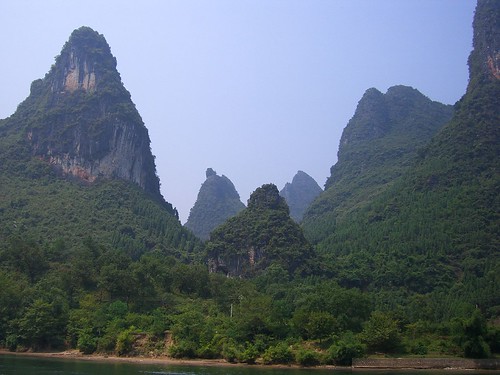 where we had an unobstructed view of the mountain ranges, animals and locals who lived and worked on the river.
where we had an unobstructed view of the mountain ranges, animals and locals who lived and worked on the river.
The boat seemed to tip from side to side as people hurried from port to starboard and back trying to photograph all of curiosities we passed.
Some of the highlights included:
- Majestic mountain ranges – the ones that the Chinese scroll artists seem to be imagining when painting those mystic fog shrouded peaks.
- The goat herders, farmers and fisherman crouched on the shore tending their crops, daily catch or unruly goats
- The parasitic “Kling-ons” who would latch their long bamboo rafts to the side of the moving boat and try to hock their cheap wares to the amused passengers on board.
- The groups of children who would swim up to the boat, hands outstretched, yelling for spare coins to be thrown to them
- Tired water buffalo cooling off in the water.
- Boats with Cormorant birds, napping after a long night of fishing. (There are still fisherman who practice this ancient technique where trained birds dive underwater and bring fish back to their master. Rings placed around their necks prevent them from swallowing their catch.)
That’s when I noticed the snake wine.
During her introduction of Guilin the day before, our tour guide mentioned some of the local Chinese medicine cures that are integral to the health care in the region. One of these medicines was a locally produced moonshine of snake soaked rice wine.
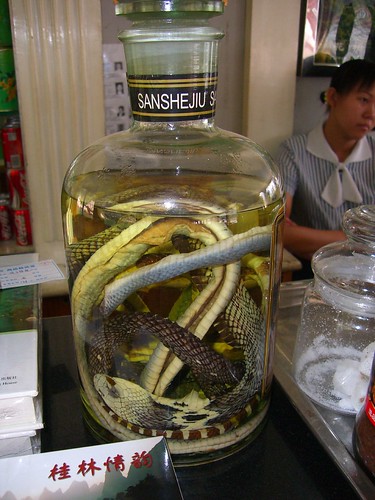 I didn’t actually expect to come across this exotic brew but there it was at the bar, a large bottle of “3 Snake Wine” with no less than all 3 of said snakes submerged in the bottle, their health-giving essence slowly merging with the slightly yellow tinged rice liquor.
I didn’t actually expect to come across this exotic brew but there it was at the bar, a large bottle of “3 Snake Wine” with no less than all 3 of said snakes submerged in the bottle, their health-giving essence slowly merging with the slightly yellow tinged rice liquor.Oh man, I gotta have me some of this snake hooch!
Cancer? Heart Disease? Impotence? Not in my lifetime! I heard it even cures general malaise and crankiness. Obviously I HAD to drink some… if only for Melissa’s benefit!
So I went around to some of the other people in the tour group and found 4 other accomplices to split the cost for a bottle.
Our bottle which was slightly smaller than the display only contained one snake but the label still claimed that cobra, rattlesnake and field snake were all used in its production. Thank God I thought. As its common knowledge that Cobra is the healthiest and most tasty!
By this time, our interest in ancient Chinese medicine produced a small gathering of curious spectators.
We each poured shot sized servings and prepared our beer chasers.
Down the hatch!
Wow that was nasty… yet smooth at the same time!
The taste would best be described as a combination of Japanese Sake and cheap tequila with subtle tones of formaldehyde and fish jerky.
Sojii, my new buddy from Toronto compared the flavor to snake ass which now that I think about it, is probably spot on though I’ve never actually tasted the ass of a snake.
After waiting a good 5 minutes, just to be sure we didn’t all keel over and die miserable and painful deaths, we finished the bottle. My mom even took a shot. Go mom!
Feeling slightly inebriated, probably due to my new found cancer fighting ability and virility, I went back to the upper deck to enjoy the rest of the cruise.
New Pictures of: LI RIVER CRUISE AND SOME HILLS AROUND GUILIN
Sunday, October 02, 2005
Frozen Army Of Stone
Xian is known as the home of the Spectacular Terracotta Soldier Army. Discovered in 1976 by a farmer digging a well, the terracotta army is the meticulously crafted life-size clay army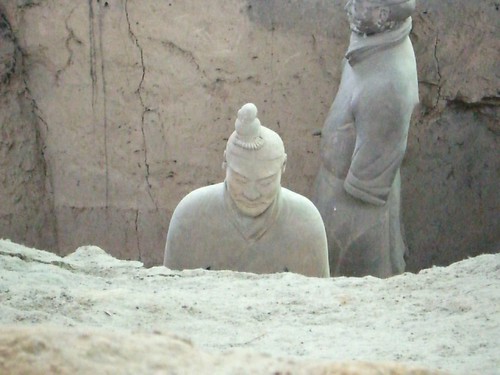 built to protect the tomb of Emperor Qin Shi Huang.
built to protect the tomb of Emperor Qin Shi Huang.
Apparently the guy was really freaked out about dying so after trying a number of immortality potions, he finally gave up trying to live forever and decided the next best thing would be to create a majestic tomb with massive army to retain his power after death. He figured the best way to do this is force 100s of thousands of workers and artisans over the course of his lifetime to construct an underground tomb and more importantly 10s of thousands of life size soldiers to protect him.
The soldiers were made of terra cotta, and individually hand constructed to show detailed facial and hair features. Furthermore, horses, carriages and weapons were all included to create an exact replica of his real-life standing army.
No big deal right? Just another ancient ruler with an Oedipus complex…? Not quite. The shear magnitude of this archaeological find is staggering… prompting the accurate comparison to the Pyramids in
So far, a little over 8000 have been uncovered and reconstructed, in 3 separate digs. These digs were our destination for our only full day in Xian.
Although the site is an hour outside of Xian in a sparsely populated part of the countryside, the government spared no expense on the facilities. The excavated sites were covered by huge blimp-hanger shaped buildings, providing accurate protection for the soldiers as well as plenty of space for the millions of visitors each year.
Additionally, there was a large museum showcasing some of the horses and carriages recovered, a decent restaurant custom-designed to handle multiple tour-bus sized groups for lunch and a circle vision move theater a la Disneyland which showed a goofy old Chinese-produced re-creation/documentary film which didn’t afford any additional insight into the history of the soldiers but did provide vertigo and neck cramps.
The big payoff of course were the soldiers themselves. We toured each of the 3 excavations, with the grand finale being the big room with 6000 of the soldiers.
I tried my best to take pictures which showed the shear scope of the excavations, but the pictures don’t do it justice. The final room was so large; it had its own hazy atmosphere. It was as if there was still dust hanging in the air kicked up from the horses and soldiers, frozen in a fierce attack stance, ready at any moment to spring to life and charge toward an invisible foe.
New Pictures: TERRACOTTA SOLDIERS, WILD GOOSE PAGODA, XIAN CITY WALL, XIAN OTHER
